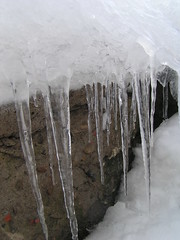Bibliographic coupling is a term coined by Kessler (doi:10.1002/asi.5090140103) in 1963 as a measure of similarity between documents. If two documents, A and B, cite a third, C, then A and B are coupled. I'm interested in extending this to data, such as DNA sequences and specimens. In part this is because within the challenge dataset I'm finding cases where authors cite data, but not the paper publishing the data.
iPhylo

Duncan Hull alerted me to his paper "Defrosting the Digital Library: Bibliographic Tools for the Next Generation Web" ( PloS Computational Biology , doi:10.1371/journal.pcbi.1000204). Here's the abstract: It's an interesting read, and it also cites my bioGUID project.
Following on from adding specimens to my OpenURL resolver, I've added support for GenBank records. Either an OpenURL request such as http://bioguid.info/openurl?id=genbank:DQ502033, or the short URL http://bioguid.info/genbank/DQ502033 will resolve the GenBank record for accession number DQ502033.
The A Shared Culture video from the Creative Commons web site.

Thinking more and more about using Mediawiki (or, more precisely, Semantic Mediawiki) as a platform for storing and querying information, rather than write my own tools completely from scratch. This means I need ways of modelling some relationships between identifiers and objects. The first is the relationship between document identifiers such as DOIs and metadata about the document itself.
Following on from the previous post, I wrote a simpe Mediawiki extension to insert a Google Book into a wiki page. Written in a few minutes, not tested much, etc. To use this, copy the code below and save in a file googlebook.php in the extensions directory of your Mediawiki installation.
I've started to come across more taxonomic books in Google Books, such as Catalogue of the specimens of snakes in the collection of the British museum by John Edward Gray. Google books provides a nice widget for embedding views of books. There is tool for generating the Javascript code. Note that in Blogger (which I use to create this blog) you need to make sure that theJavascript occurs on a single line with no line breaks for it to work.

As part of the slow rebuild of bioguid.info, and as part of the Challenge, I've started making an OpenURL resolver for specimens. Partly this is just a wrapper around DiGIR providers, but it's also a response to the lack of GUIDs for specimens.

Mike Sanderson's wall of monitors is getting some attention. Cool as it looks (and I'm positively green with envy), this strikes me as the LCD equivalent of Science's suggestion that the reader print out a tree on several bits of paper doi:10.1126/science.300.5626.169. If we can fit the planet on a monitor, can't we fit the tree of life?

The latest issue of Wired has an article on DNA barcoding, entitled "A Simple Plan to ID Every Creature on Earth". The article doesn't say much that will be new to biologists, but it's a nice intro to the topic, and some of the personalities involved.
The rather frail nature of biodiversity services (some of the major players have had service breaks in the last few weeks) has prompted me to revisit Dave Vieglais's BigDig and extend it to other services, such as uBio, EOL, and TreeBASE, as well as DSpace repositories and tools such as Connotea. The result is at http://bioguid.info/status/. The idea is to poll each service once an hour to see if it is online.